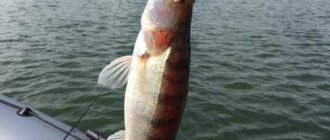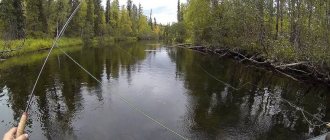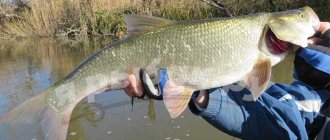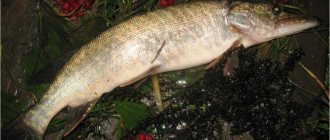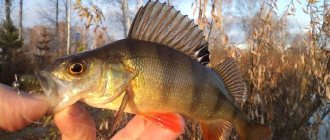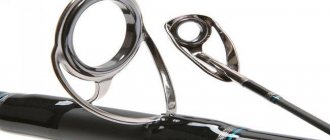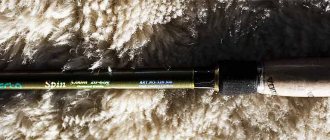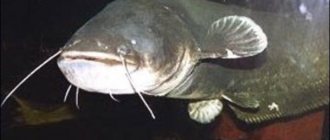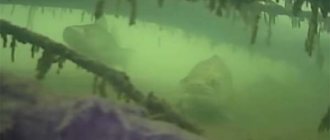Autumn spinning lures
In most cases, the choice of bait is dictated by fishing conditions:
- the object of fishing is pike, pike perch or perch;
- depth of the reservoir;
- presence of current;
- current speed;
- presence of vegetation in the fishing area;
- the presence of underwater shelters - snags, fallen trees, bridge piles, etc.
In order for spinning to give a good result in the fall, you need to take all these factors into account. Lures should be chosen so that they do not get carried away by the current and do not fall like stones into the ground. Therefore, the weight must be chosen in such a way that the game is natural. And if there are underwater obstacles near the fishing spot, then casting the bait will be painless when using non-snacking options. An excellent choice in this case would be silicone baits with an offset hook.
An important factor in autumn fishing is the size of the spinning bait. This is the period of the year when you shouldn’t go small with the size. Predators fatten up before winter, and even small specimens attack large baitfish.
A small pike can easily attack a large bait measuring 10 cm. A large bait is visible to the fish from a long distance, and it creates a stronger vibration. Therefore, if it is possible to use such sizes, then they must be used.
The most catchy baits for autumn predator hunting are limited to popular wobblers, spinners, spoons and silicone fish.
Wobblers
With minimal or no current, this bait is very promising. Since wobblers are realistic in the water, even a picky predator, after examining them first, will still attack the bait.
The most promising wobblers for pike are minnows. Jerk wiring, called twitching, is a formidable pike weapon in spinning fishing. Imitating a sick fish, the minnow wobbler brings success during pauses.
Sometimes the pause can last up to a minute, and only then does a bite follow. Wobblers from well-known companies - OSP, Zip Baits, Rapala, MegaBass - are promising and reliable. However, the price of these brands is high. In terms of price-quality ratio, lures in the mid-price segment win - Yo-zuri, Strike Pro, Usami, TsuYoki, etc. These manufacturers accurately produce copies of popular wobblers, which are inferior to analogues only in durability.
In addition to the popular minnow wobblers, fats, shads, cranks, ratlins and poppers work in some cases. These wobblers differ in the shape and nature of the game, so for finicky pike, when the fish activity is minimal, it is necessary to experiment with baits, which is helped by the variety of types and colors of wobblers.
Wobblers are pike bait. Models 3-4 cm long, which imitate small fish, are interesting to perch. And deep shad and minnows can provoke a pike perch to bite.
Spoons
The spoon is the oldest bait for catching predators, so to some extent it is already familiar to the inhabitants of the reservoir and is a little alarming. Lures of this type are often made of metal alloys. They shimmer in the water, especially in the sun. Spoons create turbulence in the water, which additionally attracts predators.
Modern spinners are endowed with stable and attractive play. They have a competitive price compared to wobblers.
Rotating spoons often have a central weight. The leader in the production of such spinners is Mepps. These baits can be caught in any type of body of water - river, lake, reservoir. And any predator can be in the catch. Mepps Aglia, Mepps Aglia Longue, Mepps Comet - these models have a wide range of sizes and work great for pike and perch.
Oscillating spoons
Oscillating spoons are unjustifiably forgotten by some spinners today. Compared to the background of a spinner or wobbler, the spinner looks primitive. But it can “shoot” where other baits will not bring results. Spreaders are promising on edges, spits and near vegetation. Products from Kuusamo, Acme, Mepps are in demand.
Silicone jig baits
Jig is considered the most promising autumn trend. This fishing method takes into account all the unevenness of the bottom, where most species of predators concentrate in ambushes in the fall.
Today, silicone jig bait is the most budget-friendly. “Edible silicone”, which is infused with flavorings, is widely popular. Depending on the intended trophy, the size of the bait varies within the following limits:
- perch - 3−6 cm;
- pike perch - 6−9 cm;
- pike - 7−13 cm.
When fishing for pike, it will be convenient to mount it on a jig head, and when fishing for pike perch, a non-snagging option with an offset hook.
Where is the predator? Fishing for pike and pike perch on the river in autumn - all the subtleties of fishing
Catching a predator in the fall
It’s no secret that every experienced fisherman has his own fishing style, his own preferences and his own tricks. In this article, a rather venerable specialist in catching predatory fish shares his secrets and subtleties of autumn fishing for pike, pike perch and perch using a spinning rod.
Catching a predator in the fall is somewhat different from summer or spring fishing. First of all, you need to take into account the changes that occur in nature with the arrival of autumn. Still, autumn gives spinners a better chance of catching predatory fish than summer. In summer, the predator is spoiled by an abundance of food; in the warm season, it is surrounded on all sides by numerous schools of small white fish. More than once I witnessed the following picture, when large perches moved lazily right in the center of a school of small roach, showing no signs of aggression towards such an appetizing environment and, moreover, not paying any attention to the bait offered to it. They looked well-fed, impudent and happy with their lives.
In autumn the situation changes dramatically. The fact is that winter is coming. By winter, the predator is faced with the task of accumulating fat for difficult times. All predatory fish begin to actively hunt. At this time, pike, pike perch and perch are joined by waterfowl, also in a hurry to feed themselves for the winter. Such active military operations break up large schools of forage fish into smaller, more mobile and less noticeable schools. In addition to this, aquatic vegetation, in colder water, sinks to the bottom and dies. The water becomes more transparent, there are much fewer places for ambush. In general, the situation is not in favor of the predator. There is no longer that satiety; on the contrary, the predator becomes more active and not as picky as in the summer. Therefore, I consider autumn to be a truly golden season for a spinning fisherman.
Now, taking into account all the changes that have occurred in nature and in the lifestyle of underwater inhabitants with the onset of autumn, a thinking fisherman must make changes to his tactics for catching predatory fish. You need to understand that at this time the predator moves to deeper places and tries to stay closer to the bottom. Steep edges are considered the most promising in the autumn period, and the sharper the difference in depth, the better. The direction of moving the bait is from shallow water to depth. For fishing in deep places, in my opinion, jig baits are the best suited. Once again I want to emphasize that this is my personal opinion, if it is more convenient for someone to catch a predator at this time with wobblers or a spinner, please do so. I want to share my personal experience; personally, the best results in autumn predator fishing were shown by jig baits, and to be even more precise, vibrating tails on a jig head turned out to be the most catchy. These baits are more universal, they work well at different depths, so with their help it is easy to cover large areas of the reservoir.
In autumn the situation changes dramatically. The fact is that winter is coming. By winter, the predator is faced with the task of accumulating fat for difficult times. All predatory fish begin to actively hunt. At this time, pike, pike perch and perch are joined by waterfowl, also in a hurry to feed themselves for the winter. Such active military operations break up large schools of forage fish into smaller, more mobile and less noticeable schools. In addition to this, aquatic vegetation, in colder water, sinks to the bottom and dies. The water becomes more transparent, there are much fewer places for ambush. In general, the situation is not in favor of the predator. There is no longer that satiety; on the contrary, the predator becomes more active and not as picky as in the summer. Therefore, I consider autumn to be a truly golden season for a spinning fisherman.
Selecting the fishing period
There is an opinion among fishermen that in late autumn predatory fish take equally throughout the day. This is not at all the case; in any case, in the waters near Moscow the predator is now still preserving the remnants of its summer behavior. It catches during the day, however, the bite is better in the morning and in the evening. Of course, today there is no point in rushing to the river before dawn. The biting time has shifted, and the busiest biting, as a rule, occurs between 9 and 12, then a break for a couple of hours, and then the biting starts again for about three to four hours. The only exception is sometimes pike perch; its bites can last until dark, until about 8-9 pm, this is apparently due to its visual characteristics. And at dusk, perch and pike stop hunting.
Therefore, it would be good to always have leashes. A pike weighing up to one kg immediately bites through any braided fishing line up to 0.4 mm in diameter, sometimes it is not possible to notice the moment. A small “push” - and the bait was no longer there.
Best time to fish
September zander fishing is practically no different in terms of bite intensity from fishing in the summer months. In relatively warm waters there are still enough available food items and the predator is picky in their choice. Hunting trips are carried out at night, when fishing is carried out from evening twilight until dawn. Quiet moonlit nights with increased atmospheric pressure activate pike perch to come out frequently. During the day, bites are very rare, and the pecked specimens do not differ in industrial size.
September
September is the month when the predator feast begins. Catfish, pike, pike perch and perch are the objects of hunting in September for spinning anglers. This month is characterized by the following features of catching predators with a spinning rod:
- Catfish and pike perch are caught on the far edges, near holes and snags in the morning and evening hours. In such places it is convenient to catch them using the jig fishing method. At night, it is possible for these predators to come out onto sand spits, where fishing with rotating spoons and wobblers will be promising.
On large rivers, pike feed during daylight hours on the near edges, where it is promising to catch them with jigs and spoons. In the mornings and evenings, the predator goes to the spits, where spinners and wobblers are more effective.
- You should look for perch on the spits and in their surroundings. In this case, it is advisable to use equipment with a bombard or a retractable leash for fishing. Small spinners and small silicone twisters would be promising baits.
- In stagnant reservoirs and tributaries of large rivers, the main object of fishing during daylight hours is pike. It is caught near the walls of reeds or cattails, next to water lily fields. Minnow wobblers and spinners will be effective in such places.
Late autumn
Photo by the author
The golden autumn has burned out. The sunny days stood long and quietly, entangled in light cobwebs - the heralds of “Indian summer”. And it seemed that this would last forever: these foggy dawns and soft days filled with golden light. But one morning the clear sky suddenly became clouded with haze, a fresh wind blew and at night the first snow fell, dusting the black earth. The icy northerner came, and it became uncomfortable in this world, which had become cold in just a few hours.
This weather has its own charm and benefits. After all, it is a sad time only for sad and heat-loving people, who perceive the arrival of early winter as a personal tragedy. And winter hasn't come yet. It was only her “scares” in the form of severe winds and early snow. Nature will still thaw and shed tears with drizzling rains, spreading the slush.
But the water is already cold in winter and is unlikely to get warmer. So, it's time for burbot. Only this night hunter likes cold and icy water. It's his time. Before winter spawning, this predator feeds intensively and robbers during the long nights of late autumn, attacking already sluggish fish that have rolled into wintering pits. Moreover, it does not disdain its smaller brethren, seeming to even give them some preference. Apparently, due to the swallowability and tenderness of small burbots...
For snacks
There is probably no simpler gear than fishing rods and donks for catching burbot. And the size of the hook does not really bother this greedy night hunter. Therefore, feeder rigs can only be used as daytime rigs, left in the water overnight. There is no point in using them for their intended purpose for catching burbot. The simplest baits are the most convenient gear for night fishing in the wind and cold. These primitive donks consist of a main fishing line wound on a reel, a heavy lead flat sinker and a leash with a large hook 10-15 cm above the sinker. It makes sense to install two leashes only in a scheme where one of the leashes will be in front of the sinker in a sliding bottom version, and the second is tied above the sinker. This scheme is used due to the fact that burbot almost never takes the second leash on the hook if it is tied above the first leash, that is, about 30 cm from the sinker. All the bites of a nocturnal predator occur mainly from the bottom.
The rough equipment of the hooks, which at first glance is a disadvantage, has its advantages. When your hands are cramped from the autumn cold and icy water, thin rigs will be too much for numb hands and unnoticeable at night. In contrast, a 0.6 mm thick line is clearly visible on the sand and is easy to hold with your fingers when casting.
The fishing line is laid out in rings on a clean bank, and test casts are made during daylight hours to determine the boundary of the riffle and the hole and establish the length of the main fishing line. With the onset of dusk, the bait hooks are baited with crawling worms, slices of chopped fish (roach and other “white” fish, ruffs, gudgeons) or live fish are attached, preferably on doubles. Then the sinker is thrown at length to the desired place and a bell is hung on the fishing line using a loop. The fishing line is fixed in a split of a flexible willow rod. The bell can be left on when fishing and casting. This makes fishing easier, although you will need to constantly rinse it or wipe the bell with a rag.
For fishing on a bank overgrown with grass and bushes, where it is impossible to lay out the fishing line in rings, the simplest “inertia-free” fishing rods, which are plastic bottles, are used. A fishing line with a diameter of 0.4 mm is wound onto the transverse recess of the bottle, and casting is done by hand, pointing the bottle perpendicular to the river, like a spinning spool. Thicker fishing line will form springy rings and become tangled.
Instead of bells, you can use feeder bells, attaching them not to the fishing line, but to the thin tip of the rod. This makes fishing even easier. In addition, the bells have phosphor details that are visible in the dark, which also serves to detect bites. The burbot does not always actively twitch on the hook, and the bell often remains silent during the smooth stretches of the nocturnal predator. In order not to pull the hook out of the burbot's throat, you need to have spare leashes. It's easier and faster than performing surgical operations with cold hands. The leash is attached to a swivel clasp attached to the main line.
In the autumn, large burbot often take fish, live or cut, especially ruff. Just don’t cut off the spines of this gloomy denizen of the depths. Burbot himself handles them very well. Fish bites are rarer. Therefore, it is necessary to bait the gear with both worms and fish. Usually the best time for burbot fishing is before 12 o'clock at night, starting at 9 o'clock, sometimes earlier. By morning, the catch of burbot is worse.
For spinners and silicone in a plumb line
Autumn fishing with spinning rods using spinners and silicone baits is, of course, much more common than using the same baits only using the vertical spinner method. Meanwhile, vertical fishing during the off-season can be quite successful and represent something like a dress rehearsal before the first ice.
If we talk about spinners, then heavy baits are used for sheer trolling at depth: three-edges for pike perch, castmasters, heavy spoons, jigs, foam fish on a jig head or on “Cheburashka” sinkers and, of course, silicone. Moreover, recently silicone has already become edible, smelling of some kind of aquatic life, whether fish, shrimp, or crayfish. This type of rubber is also suitable for sheer trolling. For catching perch at shallow depths, vertical perch spoons are very effective at this time. Here, at medium and shallow depths, perch is often caught very well with small twisters.
The technique of the game is very simple and consists only of raising the bait and lowering it down to the bottom. At the same time, twisters play very actively with their large “tails”. In a good perch spot and at the right time, this type of fishing can be very successful, especially if a catchable bait is found experimentally. Lately I have been using rubber, and often it is small twisters or silicone worms that bring luck in the form of medium and fairly large perches.
Lures that work vertically have a great advantage in the speed of the fishing process when compared with stepped spinning rods. A sparing and rational play of the spinner in a plumb line can be very effective if a school of perch is found. Here you just need to quickly remove the prey and immediately lower the bait back to the greedy jaws of the predator. Winter silver-plated spinners often stubbornly compete for success with small bright ones or, conversely, with modestly colored but cancer-smelling twisters.
Catching pike perch is also more successful in late autumn with vertical spoons than with spinning rods. However, this depends on the specific body of water and location. But on the Volga edges of the Volga region there is no more catchy tackle than a short spinning rod with a nod or a winter pike perch fishing rod with a heavy winter spinner or a massive lead jig, on the hook of which a sprat is hooked. The pike perch, which has been spoiled lately, takes lures mainly only with the addition of sprat. At the same time, the spinner can be quite simple, often a hastily made homemade product. Even “nail” baits with attached sprat that almost do not deviate to the side often catch gliding spoons. There is apparently something fascinating for pike perch in the monotonous and primitive game of “nails”. The game consists of short throws of the spoon from the bottom, but sometimes it is worth changing the nature of the game and switching to smoother and wider lifts with the fishing rod.
Pike do not actively take baits vertically, but in some places on the deep edges they are quite successfully caught using summer oscillating spoons. Fairly wide Finnish spoons, which are designed for fishing in summer and early autumn, work quite effectively. Such lures require a short and sharp swing of the fishing rod. The mode set in this case forces the bait to move far from the vertical line and make many oscillatory movements as it falls to the bottom. Even at the bottom, such a spoon makes fading movements, rotating around itself. Often these rotations are followed by the predator's grip. Therefore, it is imperative to pause, even deliberately overstaying it. Often, it is during the pause that impatient anglers lose many potential bites.
Luminous silicone baits on heavy eared “Cheburashka” sinkers are sometimes very suitable for deep-water fishing. Quite large fluorescent twisters, shrimp, octopuses and other baits visible at depth are often productive in the evenings and early dawns. Foam rubber fish also work well in a plumb line. They “poke” at the bottom and stand almost vertically, swaying under the currents. Such non-standard game often attracts curious large predators. In late autumn, trophy pike perch bites are not uncommon.
Alexander Tokarev October 28, 2021 at 05:19
October
Spinning fishing in October is the most promising of the year. Therefore, the spinner is looking forward to this month to catch trophies. The objects of fishing with spinning rods in October are pike and pike perch. To find out how to fish with a spinning rod in October, you need to use the following rules:
- October is the month of jigging, so this method is effective in any conditions. Fishing with a jig is especially promising at the end of October, when it begins to freeze at night. During this period, it is advisable to look for predators near wintering areas.
- On the river, fishing with a spinning rod in October is advisable on the edges near the holes, at the entrances and exits to the holes, near snags. Pike and pike perch can be caught in such places.
- October is favorable for pike fishing on small rivers, lakes, and streams. You need to look for it near vegetation that begins to die and turn yellow.
Zander
Pike perch is a predator from the perch family. This is one of the most popular fish among spinners. Reaches maximum dimensions of 1.2 m in length and 12 kg in weight. Typically, fishermen have to deal with a fanged robber weighing 2-4 kg and 0.6-0.7 m long.
The distinctive features of pike perch are fang-like powerful teeth, a pointed mouth and an elongated striped body.
Pike perch lives in clean rivers and lakes that belong to the basins of the Black, Azov, Aral, Caspian and Baltic seas. Does not live in bodies of water with low oxygen levels.
What to use to catch pike perch in the fall at night
It is important to throw accurately and far, and even more important - to hook the pike perch in time. Bait is used at night most often in the form of vibrotails and twisters of medium and large sizes, but they have a serious drawback - they float a lot. If the bait cannot be thrown to the fishing point, then its size needs to be reduced. The size of the bait plays the role of a provocateur. And the larger it is, the more likely a predator is to take a bite. But small twisters also perform well on autumn night waters.
You should only use twisters and vibrating tails with triple hooks on water without snags or snags, otherwise you risk a long and problematic untangling of the tackle. Such baits have proven themselves well, significantly increasing the number of bites. It is worth paying attention to the color of the bait, which can additionally attract pike perch. Bright scarlet and lemon yellow colors are a good option. If you fish with luminous paint, then you shouldn’t often charge it, because for pike perch it is more comfortable to watch the dull color emanating from an appetizing rubber fish, rather than a blurry figure of unknown origin shining in the middle of the night. This bait should be charged no more than once every half hour.
If fishing takes place on a clean bottom, then you need to use only treble hooks, since they are the ones that can give the maximum bite. In this case, empty bites will disappear. In other water places, where the bottom is not so clean, it is allowed to use large offset hooks - No. 4 and No. 5. Smaller hooks will not work as they will not be able to attach the right size bait. Good hooks are those with the tip directed towards the ring. It is better to hook with these, because their sting is slightly pressed against the silicone.
Also, when fishing for pike perch in the fall at night, you can use a bait made of foam rubber or sealant. This bait needs to be dragged slowly along the bottom.
You should only use twisters and vibrating tails with triple hooks on water without snags or snags, otherwise you risk a long and problematic untangling of the tackle. Such baits have proven themselves well, significantly increasing the number of bites. It is worth paying attention to the color of the bait, which can additionally attract pike perch. Bright scarlet and lemon yellow colors are a good option. If you fish with luminous paint, then you shouldn’t often charge it, because for pike perch it is more comfortable to watch the dull color emanating from an appetizing rubber fish, rather than a blurry figure of unknown origin shining in the middle of the night. This bait should be charged no more than once every half hour.
When is the best time to fish?
Real autumn fishing begins at the end of Indian summer, when the water temperature begins to drop and the predator fish begin to sink to depth. Fishing for pike perch in September is most successful towards the end of the month, and the bite reaches its peak activity by the middle of the next month.
Fishing for pike perch in October using a spinning rod continues almost around the clock, and the bite is greatly influenced not only by weather conditions, but by the general lighting of the water. For example, the fanged fish catches well on moonlit, quiet nights, and during the day its activity is higher when the sky is overcast.
Catching pike perch in November with a spinning rod is possible only in the southern regions or in individual reservoirs in the middle zone, where there is a discharge of warm water, for example, in the Moscow River. The activity of the predator is slightly reduced compared to October, but the bite is still quite stable and spinning anglers can fully count on catching the handsome fanged fish.
Real autumn fishing begins at the end of Indian summer, when the water temperature begins to drop and the predator fish begin to sink to depth. Fishing for pike perch in September is most successful towards the end of the month, and the bite reaches its peak activity by the middle of the next month.
November
Fishing in November with a spinning rod is often problematic - frosts occur in the mornings and the rings in the spinning rod freeze. It is necessary to spray them with silicone lubricant to make fishing possible. And at the end of November, sometimes reservoirs are completely covered with ice, so fishing with spinning rods ends at this time in late autumn.
Spinning fishing in November is unpredictable. It would seem that there are fish in wintering pits - take them and comb them with a jig. However, it doesn’t work out; the predator doesn’t take the bait. You have to try everything - edible silicone, jig spinners, spoons and deep wobblers.
In the complete absence of a bite, it is advisable to use tackle with a dead fish.
The main objects of spinning fishing in November are pike and perch. Moreover, you can look for them near holes, on edges and in river inlets. There are cases when at the beginning of winter the river was not yet covered with ice, and during this period a good feeding of pike was observed in the shallow inlet.
Spinning tackle
The choice of gear for spinning fishing in the fall is dictated by the nature of the reservoir. Depending on the type of reservoir where fishing occurs, there are two options for spinning tackle - light and heavy: Light tackle is necessary for fishing in reservoirs with minimal or no current - these are lakes, channels, oxbow lakes.
The approximate upper test limit of such gear is limited to 20 g. The rod is equipped with a reel numbered 2000 and 0.1-0.12 mm braid.
Heavy tackle is needed for fishing in reservoirs with serious currents and depths of 6-10 m. The approximate upper test limit of such tackle is limited to 40 g. The rod is equipped with a reel numbered 3000 and 0.14-0.16 mm braid.
For boat fishing with a spinning rod, the length of the rod will be 2.1-2.4 m, and for coastal fishing - 2.7-3 m. The rod must be made of carbon fiber, be rigid and fast - such qualities are required from the tackle by both jig and twitching .
During fishing, the reel clutch must be adjusted, otherwise when a strong predator bites, the braid may break or the gear may break.

